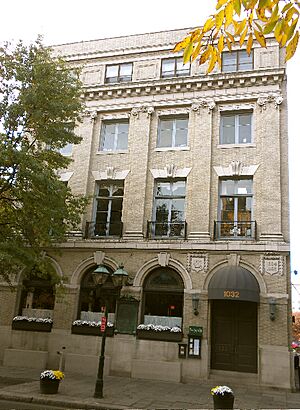Union League facts for kids
The Union Leagues were special clubs for men that began in 1862. They continued throughout the American Civil War (1861–1865). The very first group, called "The League of Union Men," started in June 1862 in Pekin, Illinois. A few months later, in November 1862, the Union League of Philadelphia was formed. This was one of the first important Leagues in the eastern United States. It is still active today, along with the Union League Clubs in New York and Chicago.
These clubs were created to support the United States Union during the Civil War. They also backed the new President, Abraham Lincoln, and wanted him to be re-elected in 1864. The Leagues worked against people called "Copperhead Democrats." These groups were against the war and against rights for Black people. The Union Leagues thought their actions were harmful to the country. At first, the Leagues were not linked to one political party. But by 1864, they openly supported the Republican Party and Lincoln. They also supported any Democrats who were loyal to the Union.
The biggest and most famous Union Leagues were in Philadelphia, New York, and Boston. Wealthy men were members of these clubs. They raised money for groups that helped with the war. For example, they supported the United States Sanitary Commission. This group provided medical care for soldiers who were hurt in battle. The military was not ready for how many soldiers would need help.
At the same time, many other Union Leagues started across the North. These were mostly for working-class men. Women also formed groups called Ladies Union Leagues in many towns. By spring 1863, most of these groups joined together under the Union League of America (ULA). Its main office was in Washington, D.C.
Contents
After the Civil War
Helping Freed People
After the Civil War, during the Reconstruction era, Union Leagues also formed in the South. This was after 1867. They worked closely with the Republican Party and were supported by people from the North. These were secret groups that helped freedmen (newly freed Black people) to register and vote. They taught freedmen about political issues and how to vote for the Republican Party. They also helped with community projects.
Historian Eric Foner wrote: "By the end of 1867, it seemed that almost every Black voter in the South had joined the Union League or a similar group. Meetings usually took place in a Black church or school."
The Ku Klux Klan was a secret group of white supremacists. They were against civil rights for Black people. They sometimes attacked and even killed leaders of the Union Leagues.
Good Deeds and Famous Members

After the Civil War, the Union League Club of New York started supporting many other good causes. For example, they helped create the Metropolitan Museum of Art. They also helped pay for the base of the Statue of Liberty and for Grant's Tomb.
Some old Union League buildings are now used for other things. In Brooklyn, New York, a former Union League Club building is now a home for senior citizens. The old Union League building in New Haven, Connecticut, is now a restaurant. This building is on the site where founding father Roger Sherman once lived. Even George Washington visited Sherman's home! In 1949, members of the Union League Club of Chicago started the Union League Civic and Arts Foundation. This is a non-profit group that works to improve the community through education and charity.
Notable Members
Many important people were members of the Philadelphia Union League. These included Cyrus McCormick, Robert Todd Lincoln, Adolph E. Borie, Daniel Burnham, William D. Boyce, Charles D. Barney, and George J. Smith.
See also
 In Spanish: Liga de la Unión para niños
In Spanish: Liga de la Unión para niños
- Union League of Philadelphia
- Union League Club of Chicago
- Union League Club of New York
- Union League of America Hall
- Union League Golf and Country Club
- List of American gentlemen's clubs



